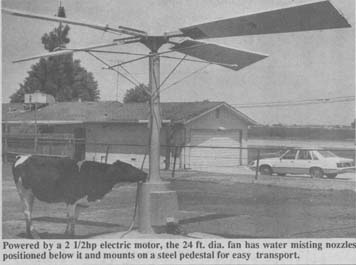
If California ag engineer Bill Fairbank has his way, feedlots and pastures all across the country will soon be sprouting giant cattle fans that make corrals look like they've got helicopters parked in them.
The University of California extension researcher has designed a barnyard version of overhead paddle fans used in homes and offices. His fan is 24 ft. in dia. from blade tip to blade tip and has water misting nozzles positioned below it.
The fan, which mounts on a steel pedestal and can be moved easily from place to place, is powered by a 2 1/2 hp electric motor. "It spins slow at about 44 rpm's but blade tip speed is the same as on a 48-in. dia. fan," says Fairbank, who says the optimum speed may be even slower at about 36 rpm's. This is the second summer that the giant fan is in testing.
With a power consumption of just 2 watts per hour, the fan costs mere cents per hour to run, depending on local electrical costs. The motor direct-drives the fan through a 38.4:1 gearbox. The fan, which weighs 1,200 lbs., can be picked up by a front-end loader. It requires only electrical hookup to 110 volts and connection to a water hose with normal water pressure. The 2-in. dia. center pipe carries electrical and water lines.
There are four mister arms positioned just below the fan blades. Each arm is fitted with two 1.5 gpm nozzles for a total water requirement of 12 gpm.
"It can be positioned anywhere. One fan will cool approximately 100 head of cattle. The slow speed fan provides just as much cooling as higher speed fans. Some animals don't like fast-moving airstreams," says Fairbank. He says that in testing he's found that the fan can eliminate feeding problems caused by hot weather. The fan can be positioned next to dip pens, in runways between corrals or under shade areas.
The lightweight blades are 1 3/8-in. thick with a wood frame and a foam-filled inner cavity. Each blade weighs less than 40 lbs. Because the blades spin so slowly, their design does not have to be aerodynamically perfect.
Fairbank can provide literature on his prototype models or refer interested readers to the manufacturer he's been working who will build fans on a custom basis.
